In the heart of our homes and cities, a hidden network of drains ensures the seamless flow of water and waste, which is pivotal to our daily routines and environmental health.
When this flow is interrupted by drain blockage, it can lead to a cascade of problems. Let us understand the reasons behind the drain blockage and how to clear it.
Looking for a drain unblocking company in the UK- Connect with us.
Call us at 0800 999 1769 or 0203 337 0349 or email at info@bndrainageltd.com.
The ten common causes of drain blockage
Let us understand ten common causes of drain blockage:
1. Hair Accumulation
One of the leading causes of drain blockage is hair accumulation in shower and bathtub drains. Hair binds with grease and other substances, creating clogs that prevent water from running smoothly.
Cleaning your bathroom and shower drains regularly can help in preventing from drain blockage.
Connect with us for unblocking showers and clearing bathroom drains.
2. Fat and Oils
Over the years, fats, oils, and grease from cooking can solidify inside the pipes, leading to a significant blockage in kitchen pipes. These substances stick inside the drainpipes, gradually obstructing the water flow.
It is advised to dispose of grease and fat in the trash rather than throwing them into the drainage.
3. Food
Sometimes, not just oil or fat but food is tossed into the drainage. Certain types of food waste should not go down the drain. Items like coffee grounds and eggshells do not break down easily and can cause more blockage. A sink strainer is advised to catch such food and prevent drains from clogging.
4. Soap Scrum
Soap bars are usually made up of fat and grease, which are later combined with water minerals to form soap scrum. Over time, this scum can line pipes and restrict water flow, leading to blockages.
It is advised to switch to soap-free washes and reduce the soap scum and, after that, blockage.
5. Foreign Object
Non-biodegradable products such as wipes, sanitary products and cotton swabs can easily block the drain when flushed down toilets or dropped into drains.
It is essential to dispose of such items in a trash can or in a proper manner so that drains aren’t clogged.
6. Mineral Build-up
In areas with harsh water, minerals dissolved in the water can precipitate out and accumulate inside pipes, reducing flow and causing blockage.
It is advisable to install a water softener to prevent this build-up and prevent drains from blockage.
7. Tree Root Infiltration
The root of the tree can grow into pipes through tiny cracks, seeking water and moisture. Over time, this growth can cause significant blockage and even damage the pipes.
Regular inspections can help identify this problem at an early age, and these trees can be removed by professionals.
8. Toilet Paper Overuse
Using too much toilet paper or flushing toilet paper or sanitary napkins can block the drain. It is important to think before flushing the items so that the sewer line is not blocked.
9. Small Objects
Accidentally, small things like pens, toys, and other objects fall into drains or get stuck, which prevents water from draining and, therefore, clog drains.
Installing drain guards that can catch undesired products from sliding into the drains is advisable.
10. Pipe Scale and Corrosion
Pipes can corrode or become encrusted with scale over time, particularly in areas with harsh water.
This not only causes blockage but also weakens the pipes, which can lead to pipes bursting or leaks in pipes.
Recognising blocked drain warning signs
Before clogging and blockage become serious issues, here are some of the warning signs:
1. Slow Draining Water
One of the earliest warning signs of a blocked drain is water draining slowly from sinks, showers, or baths. This suggestive draining indicates that there may be some hindrance in the pipes, reducing the speed of water.
2. Gurgling Sounds
If you hear gurgling sounds coming from your drains or toilets after using them that means water pipes need to be fixed. This indicates air is trapped due to blockage. These sounds typically occur as air bubbles try to escape through the clog.
3. Unpleasant Odours
Residents smelling foul odours emanating from drains, sinks, and toilets are clear indications of blocked drains. The stagnant water trapped behind the obstruction can produce an unpleasant smell similar to rotting food or sewage.
4. Rising Water level in toilets
If the water level in toilets goes higher than usual or takes longer to flush whenever you are flushing, that means there is a blockage in the main line, or the sewer is clogged.
5. Damp patches or water stains
If you notice damp patches or water stains on the walls, ceilings or the floor near water fixtures, that means a blocked drain causes a leak. Blocked drains can lead to overflowing water, which can seep into surrounding surfaces.
6. Visible Debris
Sometimes, residents may observe debris, hair, or any other material blocking the drains, which is a clear sign that there is more blockage further down the pipe.
Contact BN Drainage
Conclusion
Preventing these common causes of drain blockage primarily revolves around mindful usage of your plumbing system and regular maintenance. You need to be cautious while combing your hair and flushing. Food should be thrown in trash cans, and professional inspections should be done from time to time.
About us- Choosing the right drain blockage service
Here at BN Drainage, we can find solutions for any drainage issues at your residential or commercial property. Our team will put your mind at ease, allowing you to sit back and relax while the problem that has been affecting you is expertly resolved. Finding a drainage issue in your property is always frustrating, so you must call for professional help from a trustworthy company.

